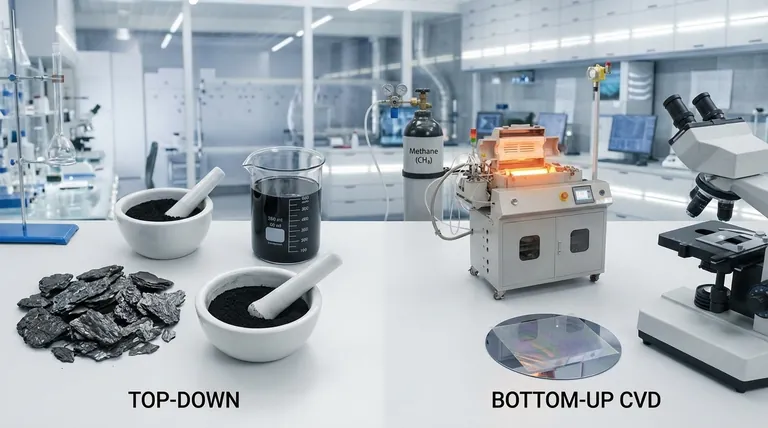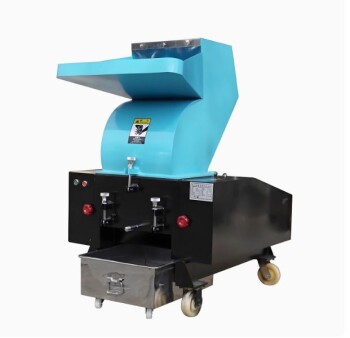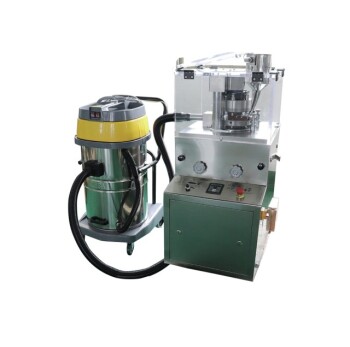To determine the "best" source of graphene, you must first define your application, as the ideal source material is directly tied to the production method and the desired quality of the final product. The two primary sources are natural graphite, used in top-down exfoliation methods, and methane gas, used in bottom-up synthesis like Chemical Vapor Deposition (CVD).
The choice of a graphene source is not about finding a single "best" material, but about navigating a fundamental trade-off: the high volume and low cost of graphite-derived flakes versus the high quality and high cost of sheet graphene grown from precursor gases.

The Two Fundamental Production Paths
Graphene is not mined directly; it is produced from a carbon source. The method of production dictates which source is appropriate and what kind of graphene you will get.
Top-Down Exfoliation: From Graphite to Graphene
This approach starts with a bulk material—graphite—and separates its layers to produce graphene. It's analogous to splitting a deck of cards into individual cards.
The primary source for this method is natural graphite. The process mechanically or chemically exfoliates the graphite, yielding products like graphene nanoplatelets (GNPs) or graphene oxide (GO).
This method is highly scalable and cost-effective for producing large quantities of graphene in powder or dispersion form.
Bottom-Up Synthesis: Building Graphene Atom by Atom
This approach constructs the graphene lattice from the ground up, typically on a substrate. The most common method is Chemical Vapor Deposition (CVD).
Here, a carbon-containing gas is introduced into a high-temperature furnace, where it decomposes and the carbon atoms arrange themselves into a single, continuous sheet of graphene on a metallic catalyst (often copper).
This method produces extremely high-quality, large-area graphene films with minimal defects, which is critical for advanced applications.
Evaluating the Primary Carbon Sources
The choice between the top-down and bottom-up paths leads directly to the selection of a source material.
Natural Graphite: The Workhorse for Bulk Applications
Graphite is the source for all top-down methods. Its abundance and relatively low cost make it the go-to material for applications requiring large volumes of graphene.
The resulting graphene flakes are ideal for mixing into other materials to enhance their properties, such as in composites, polymers, coatings, and energy storage devices.
Methane Gas: The Standard for High-Purity Films
For the bottom-up CVD method, methane (CH₄) is the most popular and reliable carbon source.
Its simple molecular structure allows for clean decomposition and predictable growth, resulting in the highest-quality single-layer graphene sheets. These sheets are essential for high-performance electronics, sensors, and transparent conductive films.
Alternative Sources: The Push for Lower Costs
Research is ongoing to find less expensive carbon sources. Petroleum asphalt, a byproduct of oil refining, is one such option.
While it is an inexpensive source of carbon, it is more difficult to process and often results in lower-quality graphene compared to methane. These alternative sources represent a drive to lower the cost of CVD-grown graphene but come with significant processing challenges.
Understanding the Trade-offs
The "best" source is a balance between your technical requirements and your budget.
Cost vs. Quality
Top-down exfoliation of graphite is far less expensive for producing bulk tonnage. However, the material consists of flakes of varying size and thickness, with more structural defects.
Bottom-up CVD from methane is significantly more expensive per unit area but produces near-perfect, single-layer graphene essential for high-tech devices.
Form Factor and Application
Graphite-derived sources produce powders or liquid dispersions. This form factor is designed to be an additive. You mix it into plastics, resins, or inks.
CVD-based sources produce continuous, transparent films on a substrate. This form factor is designed to be a functional layer in a device, like a touch screen or a transistor. You cannot use it as a bulk additive.
Making the Right Choice for Your Application
Your end goal dictates the correct source and method.
- If your primary focus is bulk material enhancement (composites, coatings, concrete): Your best source is natural graphite, processed via top-down exfoliation to create graphene nanoplatelets or graphene oxide.
- If your primary focus is high-performance electronics, sensors, or transparent films: Your best source is methane gas, used in a CVD process to grow high-purity, single-layer graphene sheets.
- If your primary focus is cost reduction for industrial-scale CVD production: Exploring alternative sources like petroleum asphalt is a valid R&D path, but be prepared for significant processing and quality control challenges.
Ultimately, aligning the graphene source with your specific application's cost and performance requirements is the key to a successful outcome.
Summary Table:
| Source Material | Production Method | Key Characteristics | Ideal Applications |
|---|---|---|---|
| Natural Graphite | Top-Down Exfoliation | Cost-effective, scalable, powder/dispersion form | Composites, coatings, energy storage, polymers |
| Methane Gas | Bottom-Up CVD | High-purity, large-area films, minimal defects | Electronics, sensors, transparent conductive films |
| Petroleum Asphalt | Alternative CVD | Low-cost, challenging processing | Industrial R&D for cost reduction |
Struggling to choose the right graphene source for your lab's specific application? KINTEK specializes in lab equipment and consumables for both top-down and bottom-up graphene production. Our experts can help you select the perfect materials and equipment to achieve your desired graphene quality and cost targets. Contact us today to discuss your project and discover how we can support your research and development goals!
Visual Guide

Related Products
- Customer Made Versatile CVD Tube Furnace Chemical Vapor Deposition Chamber System Equipment
- Chemical Vapor Deposition CVD Equipment System Chamber Slide PECVD Tube Furnace with Liquid Gasifier PECVD Machine
- Vacuum Sealed Continuous Working Rotary Tube Furnace Rotating Tube Furnace
- Inclined Rotary Plasma Enhanced Chemical Vapor Deposition PECVD Equipment Tube Furnace Machine
- Vacuum Hot Press Furnace Machine for Lamination and Heating
People Also Ask
- What are nanotubes drawbacks? The 4 Major Hurdles Limiting Their Real-World Use
- How high of temperature do carbon nanotubes in air have the ability to sustain? Understanding the Oxidation Limit
- What are the methods of producing CNT? Scalable CVD vs. High-Purity Lab Techniques
- Are all lab grown diamonds CVD? Understanding the Two Main Methods
- How do nanotubes affect the environment? Balancing Low Carbon Footprint with Ecological Risks



















